#ORANGEGLO WATERMELON
Photo

Rare Exotic ORANGEGLO WATERMELON Seeds, Tropical Fruit Seeds, Non-GMO, Organic, Heirloom B10 Beautiful, deep orange flesh; very sweet, excellent, almost tropical flavor! The best-tasting of ALL orange varieties we tried—the favorite of many who tried it at our place. High yields. Very resistant to wilt and insects; strong healthy vines. These will sell at roadside stands & markets! Introduced by Willhite Seed Co. prior to 1965.
Count 10
Days to Maturity: 85-90 Days Full Sun Seed Depth: 1/2" Sprouts in 7-14 Days Ideal Temperature: 75-90 Degrees F Plant Spacing: 18" Frost Hardy: No Citrullus vulgaris
French heirloom variety 2 lb. fruits with small seed cavities Sweet, richly flavored flesh with a powerful fragrance Open-pollinated A flavor unlike modern melons
Growing Tips: Direct seed, or set out indoor-started transplants after the last frost date when really warm weather has arrived. Needs rich soil (amend with compost) and plenty of moisture.
Prepare the soil for the watermelon planting about 2 weeks before the average last spring frost date in your area. 1. Use compost and fertilizer. 2. Form six to eight-inch high raised beds to speed soil warming and have good drainage. 3. Plant the seeds ½ to one inch deep. 4. Sow 2 or 3 seeds in groups 18 to 24 inches apart.
How do you take care of a watermelon plant? Keep the plants well-watered at all times, especially when flowering and fruiting, and feed weekly with a high potash liquid plant food once the first fruit has set. Pinch out the growing tips at the fifth leaf to encourage side shoots, which will bear the flowers.
The key to growing a successful crop of watermelons is heat. Don’t even start planting your melons until soil temperatures are above 70 degrees. They also like well-amended and very nutrient-rich soil. Working a generous amount of compost and composted manure into the soil before planting will set your watermelons up for success.
Watermelons are ready to harvest once the melon "slips" from the vine when gently tugged. Don't leave them too long, however, as ripe watermelons have a sweet aroma that attracts insects.
FREE GIFT when you order 5 items or more. Free gift is full of surprise seeds which may include single or mixed varieties.
Note: No tracking # will be provided to make the shipping cost-effective for us and free for you. Returns & exchanges are not accepted. But please contact me if you have problems with your order http://springsofeden.myshopify.com/products/rare-exotic-orangeglo-watermelon-seeds-tropical-fruit-seeds-non-gmo-organic-heirloom-b10
#Amish Melon#Citrullus vulgaris#Delhi Melon#French Cantaloupe#Kajari melon#Kanjari#ORANGEGLO WATERMELON#organic seeds#rare seeds#Thai Golden Round#watermelon
0 notes
Text
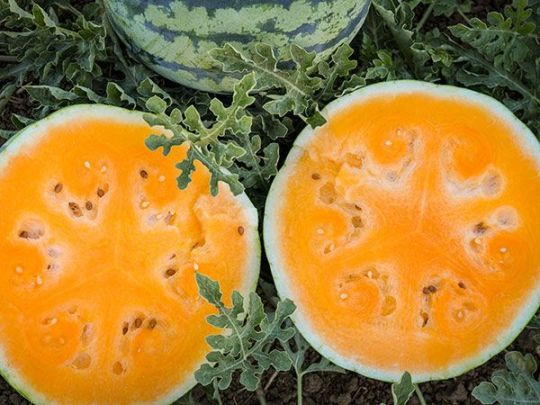
Leelanau Sweetglo Cantaloupe (Citrullus vulgaris)
80 days. Amazing deep, tangerine-orange fleshed fruit are sugar sweet! Perhaps the most perfectly flavored watermelon we have tried! In 2008, Mike Kiessel, watermelon expert of Leelanau County, Michigan, decided to cross the Orangeglo watermelon with a Crimson Sweet. After years of selecting and perfecting, the Leelanau Sweetglo has completely won our hearts and triumphed at our annual tasting trials! A new favorite orange-fleshed variety that matures early and is excellent for northern growing.
Full Sun
Sprouts in 5-10 Days
Ideal Temperature: 70-95 Degrees F
Seed Depth: 1/2-1 inch
Plant Spacing: 3'
Frost Hardy: No
Citrullus vulgaris
Growing Tips: Direct seed, or set out indoor-started transplants after last frost date when really warm weather has arrived. Needs rich soil (amend with compost) and plenty of moisture.
#p#dream garden#cantaloupe#melons#gardening#urban gardening#wfpb#heirloom varieties#hybrid varieties#raw vegan#fruitarian#whole food plant based#nutritarian
8 notes
·
View notes
Link
1 note
·
View note
Text
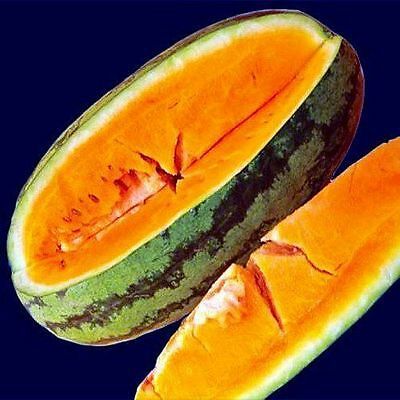
Orangeglo Watermelon 20 Seeds Sugary, Delicious, and Crisp Fruits http://rover.ebay.com/rover/1/711-53200-19255-0/1?ff3=2&toolid=10039&campid=5337982659&item=291992462438&vectorid=229466&lgeo=1&utm_source=dlvr.it&utm_medium=tumblr
0 notes
Text
Otra vez, tiempo sin verte. Pasó la temporada de sequía entera sin ningún post aquí. No es que no haya mucho que reportar, sino que sólo tengo internet por (sumamente caros) datos en el campo y eso complica bastante lo de mantener un blog. Ya estamos entrando a la temporada de lluvias y todo es sembrar sembrar sembrar. Pero claro, hay que dar esos cortes de pelo a la jungla así que también es machetear machetear machetear.
Haciendo todo eso, aproveché de sacar fotos de casi todos los árboles y arbustos, es decir, los perennes de largo plazo no las hortalizas, que hemos sembrado desde el principio aquí. Algunos tenían varios años y otros varios minutos cuando saqué su foto. Realmente son para documentar la siembra que hemos realizado en el terreno hasta ahora, no para mostrar bonitas imágenes listas para Pinterest. Voy a publicarlas aquí en los próximos posts (hay límite de 10 imágenes por post), algunas con comentarios y otras no, por posteridad.
Mientras tanto, para continuar del post anterior. Sí hemos logrado una cosecha continua y prodigiosa de berenjena variedad Ping Tung Long y también Aswad. El PTL es de Taiwán, produce cantidades abrumadoras de berenjenas largas color violeta. Son tiernas y casi sin semillas hasta cuando crecen grandes. El Aswad es iraquí. Son grandes, casi negras, redondas. Son más carnosas, con sabor delicioso. Pero siendo grande tardan más en madurar y no producen tan prolificamente. Me encantan las dos.
Por otro lado seguimos luchando con los tomates que se enferman de una cosa u otra hasta durante la sequía. Pero sigo sembrándolos, y experimentando con injertos. Venceremos.
Ahorita en el huerto más allá de las berenjenas y tomates tenemos: maíz amarillo criollo ya llegando a mis rodillas, maní, sorgo criollo para la cultivación de hongos y tal vez para las gallinas, auyama variedades Rampicante (también se come tierna como calabacín), Greek Sweet Red, Butternut, y Chiriman, vainita Rattlesnake Pole, frijol Snowcap, habas (para cosechar secas y usar en una salsa picante fermentada china), chia, brócoli brasileño Piracicaba, repollos verde y morado, amaranto (para las gallinas), arúgula, cebollín, pimentón, ají picante variedades Ají Amarillo, Korean Dark Green y Chile de Árbol, patillas Orangeglo, Ali Baba, y Strawberry, más varias hierbas y flores.
Me referí a las gallinas. Tenemos gallinas? Pues, no, no todavía pero sí vienen! En un mes vienen. Lo que significa que necesitamos malla gallinero y los precios hoy en día hacen eso imposible. Iba a hacer un GoFundMe pero me borraron la cuenta por mencionar Venezuela resultado de las sanciones (no, no sólo afectan al gobierno). Así que vamos a hacer un GoFundMe sin GoFundMe. Un camarada virtual @Tenji95 nos hizo el gran favor de diseñar un panfleto para promover la campaña. Ella es un gran ejemplo de un activista que hace más que habla, y de solidaridad. Un abrazo. Vamos a publicar el panfleto pronto para cualquiera que quisiera donar ya, puedes usar este link: paypal.me/casaabyayala. Cualquier cantidad ayuda!
Once again, long time no see. The entire dry season came and went without a single post on here. Not that there wasn't plenty going on, but here in the mountains I only have extremely expensive data for internet, which complicates the whole blogging thing considerably. Now the rainy season had begun again and it's all about planting planting planting. Plus we have to give those haircuts to the encroaching jungle so it's machete machete machete.
While doing all that, I went around and took pictures of almost everything we've planted over the last however many years - trees and bushes, as in long-term perennials not the ever-evolving kitchen garden. Some had been in the ground for years and others just a few minutes when I took the pictures, which are really for documenting our progress not for pretty Pinterest pics. I'll be posting them in upcoming posts (there's a 10 picture limit per post), some with commentary some without, just to save them for posterity.
Meanwhile, to continue from the last post. We have managed copious harvests of eggplant - Ping Tung Long and Aswad. Taiwanese PTL produces long slim violet fruits like crazy, Aswad is from Iraq and it makes gorgeous round almost black fruit. PTL is tender almost to a fault, almost no seeds and never bitter even when they get big. Aswad is meatier with a delicious flavor, produces slower because the fruits are much bigger. I love them both.
On the other hand we're still struggling with tomatoes, plagued by disease issues even during the dry season. I keep planting them, though, and experimenting with grafting too. Never say die.
Now in the garden other than eggplants and tomatoes we have: local yellow corn for cornmeal now up to my knees, peanuts, local sorghum for seeds for mushroom cultivation and the chickens, squash varieties Rampicante (you can eat it as summer or winter squash), Greek Sweet Red, Butternut, and Chiriman, Rattlesnake Pole beans, Snowcap beans, limas (to harvest dry for a fermented Chinese hot sauce), chia, Brazilian Piracicaba broccoli, green and purple cabbage, amaranth (for the chickens), arugula, green onion, pepper, hot pepper varieties Ají Amarillo, Korean Dark Green and Chile de Árbol, watermelon Orangeglo, Ali Baba, and Strawberry, plus various herbs y flowers.
We have terrible nematodes and we're struggling with powdery mildew, so there are lots of failures along with the successes. But we're producing our own food more and more. And of course the veggies go along with the fruit tree crops, those we've planted plus those we inherited with the house. Now that we've been in the house a full year we've enjoyed citrus, avocado and sapodillas (which when they get too big to ripen well are absolutely divine dehydrated).
I mentioned chickens. Do we have chickens? Well no, not yet. But they're coming in a month! Which means we need chicken wire, an impossibility at current economic war prices. I was going to do a GoFundMe but they deleted my account for mentioning Venezuela due to the sanctions (no, they don't just affect the government). So we're going to do a GoFundMe without GoFundMe. A virtual comrade @Tenji95 did us the huge favor of designing a flyer to promote the campaign. She's a great example of an activist who does more than she talks, and of real solidarity. Un abrazo. We'll be publishing the flyer here soon but if anyone wants to jump in and donate to the chicken wire fund now you can use this link: paypal.me/casaabyayala. Any amount helps!
Unas fotos de cosechas
Some harvest pics (The cukes are a fantastic Japanese variety Aonaga Jibai. Saved seeds of that one.)
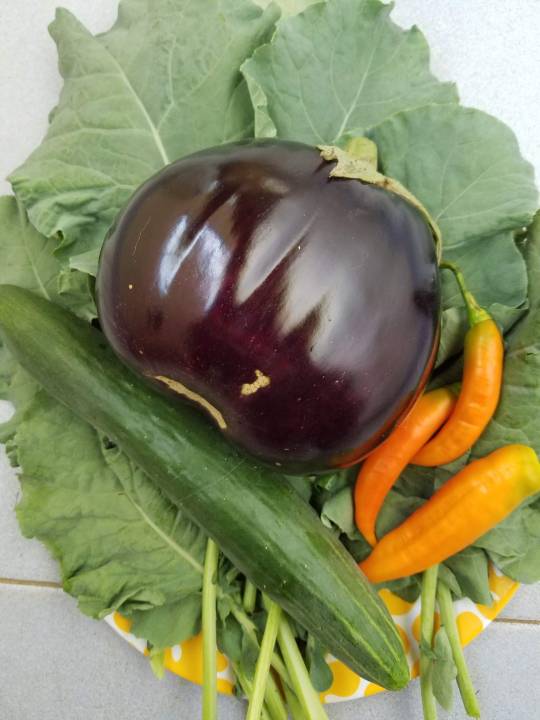
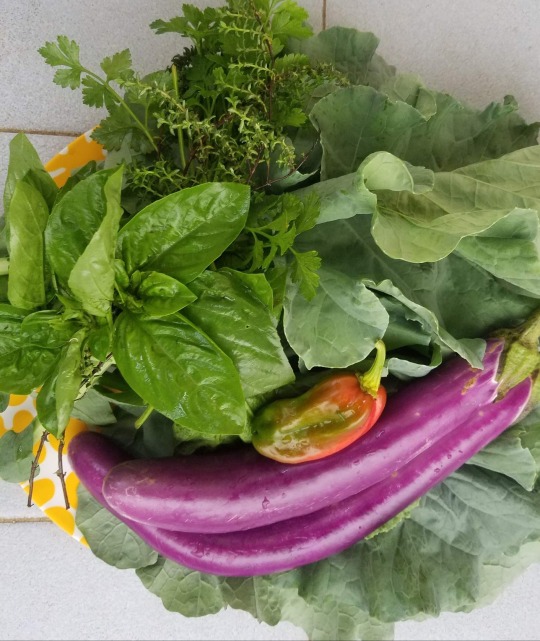
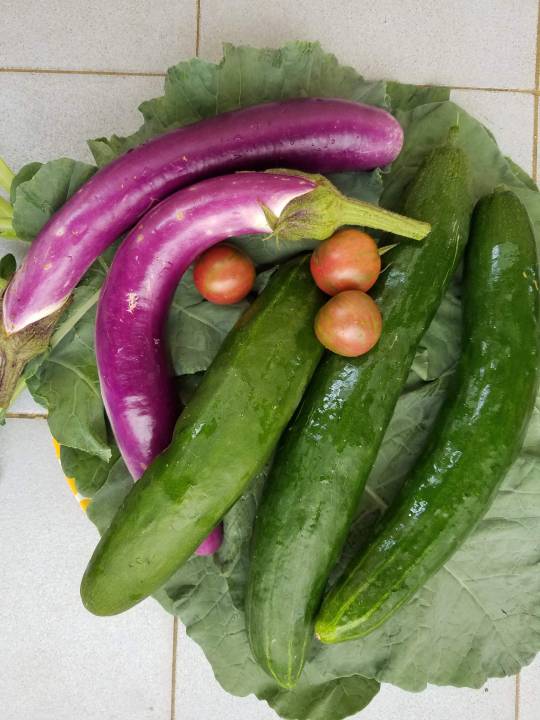
Y una toma eliminada de nuestros selfies para la campaña
And an outtake from our selfie attempts for the campaign

0 notes
Text
Summer Garden
Got my first cucumber, a White Emerald heirloom, out of the garden today. There's another ready to come out in the next day or so, and by midweek next week, it'll be a cucumber explosion. Unfortunately, I got my plants in the ground a month late as I was trying a bunch of horticulture magic and had a few mishaps. I actually started a bunch of seedlings back in late February and the basement got too cold and the seedlings petered out. But my small garden I think will produce quite a bit for being as small as it is as I gave the plants like the cucumbers and watermelon room to spread. All plants are heirloom/non-GMO. I have 2 Orangeglo and 1 White Wonder watermelon. Then a mix of tomatoes, some cherry, and some large. They've all done quite well, no mold or fungal issues whatsoever. I planted them in about a 3 gallon hole with a 10-1 black kow/soil mix and a couple handfuls of blood meal. This is actually what I did with every plant. So far about the only issue I've had was the roots just being slow to take off on the tomatoes. They were using a lot of water, in which case you'll run into issues with mold and fungus because the soil states wet. To fix this, prune off all branches except the very top few. This slows water consumption and gives the roots a chance to develop. I did this with the tomatoes and peppers. Another thing you can do is mound black kow at the base up to mid to 3/4 of the entire stem. Then cover that with grass clippings to keep your mound from eroding. The stem readily roots out into the mound giving structural support and a larger rooting zone. More root is always better, makes the plant more drought resistant.
1 note
·
View note
Text
12 Mouth-Watering Facts About Watermelons
New Post has been published on http://www.infolibrary.net/12-mouth-watering-facts-about-watermelons/
12 Mouth-Watering Facts About Watermelons
The watermelon, a simple everyday fruit that, in my opinion doesn’t even make into my top 5 – but I know for a fact that many people adore the watermelon.
Either the fruit or the juice is a cool refreshing option on those hot summer days – or lazing beside the pool.
Whether blitzed, chunked or as a mixer, this fruit really does epitomize summertime.
Here were going to look at 12 mouth-watering facts about this big green gem.
The most expensive watermelon ever sold was a Densuke, auctioned in 2008 for a staggering Y650,000 or $6300 it was one of the first harvested in Hokkaido. This Japanese fruit is pure black and averages a price of $250 per fruit! In 2014 Japan’s obsession with auctioning this fruit for extortionate prices continued with one specimen from Toma, Hakkaido being sold for Y350,000 or $3000.
The watermelons origins are much unknown, many theories are held around the world but the big contender is that this fruit is thought to originate in Egypt around 4000 years ago. Hieroglyphs and images are found all around Egyptian tombs and paintings including King Tuts very own. The main theory that the Egyptians cultivated the same fruit we know today is all down to one image that depicts an oblong fruit much like the one we all recognize.
Watermelons, and in particular their seeds, are held highly across Asia for their flavor and are often a vital part of celebrating national holidays. In china the seeds are eaten during Chinese New Year and in Vietnam during their New Year celebration Tết, the seeds are a tasty snack.
In 2014 a man was allegedly arrested after his partner felt threatened when returning home to find a watermelon stabbed with a butcher’s knife. The woman who had recently attempted to turn the man in for drug offenses following the discovery of marijuana came home to find the impaled fruit and felt it was left there to intimidate her. The suspect came in and apparently started cutting up the fruit, he was later bailed.
Watermelons always seem to be the go-to-fruit for any chopping, smashing, slashing or squeezing demos and there are an array of world records for doing just that. In 2014, Olga Liashchuk crushed 3 watermelons with her bare thighs in 14.65 seconds and in 2006 Leonardo D’Andrea smashed 10 watermelons with his head in 16 seconds, both securing Guinness World Records for their efforts.
Watermelons can be kept edible for months if kept at the right conditions, the Egyptians, and many other cultures, cultivated this plant just for this very reason. With water being so short, and watermelon being over 91% water, the fruit could keep fresh and utilized during times of draught by smashing it to a pulp and drained. According to the National Geographic, this technique was demonstrated to one of their reporters in 1924 in the Sudan.
What fruit poses a risk to Israeli security? The watermelon of course. Apparently a Palestinian man was refused entry to his home in Hebron in June 2016 after he tried to cross a closed military zone with a watermelon. The man, melon in hand, wanted to enter the zone to go home was told by 25 Israeli soldiers he wouldn’t be entering and was made to stand there for 4 hours awaiting a decision to let him pass.
The watermelon contains over 91% water, this level is the same as that found in the human brain and this means the fruit is recognized as one of the best in the world for hydration.
Watermelons are a medicinal marvel supposedly helping in an array of different ways. The juice can reduce muscle soreness as it contains Citrulline which lowers blood pressure, it can improve eyesight and eye health as it’s so high in Vitamin A, and due to the high concentration of Lycopene, a phytochemical, it can lower the risk of cancer.
Even though we all have the same image come into our heads when we think of the humble watermelon we couldn’t be further from the truth for many of the species of this fantastic fruit. There are over 1200 varieties of watermelon all differing in texture, taste and appearance, some being solid black like the densuke and some having yellowish flesh like the orangeglo. Over 300 varieties are grown in the U.S. alone.
In 2013 in Tennessee USA, Christopher Kent set the Guinness World Record for the largest and heaviest watermelon in the world, weighing an unbelievable 350.5 lbs (159 kg), to put this in perspective the average watermelon weighs in at 25 lbs (11.33 kg) so Chris’ specimen was 14 times heavier!
Pac-Man was the first time the watermelon made a video game appearance. In the 1980 Namco cult classic the watermelon is the highest scoring prize, it can be eaten during gameplay for a 1000 point boost. The watermelon has now appeared in hundreds of games.
Whether you hate it or love it, one thing’s for sure, the watermelon really is a huge hit worldwide. Albeit $5 from the local supermarket or $6,000, this watery little wonder really has got an array of uses and the list of facts I’ve given above barely scratched the surface.
The watermelon has been held highly throughout the ages and now with brands jumping on the watermelon bandwagon of late with new drink concoctions (Jack Daniels) or vaping liquid I don’t see the craze going away any time soon. So grab a wedge, sit down with a nice book and enjoy… oh and if you visit a friend why not take one along, that’s the traditional gift for a host in Japan.
Dan Lewis has worked in the tech sector for about 7 years and is qualified in most areas including networking, hardware, software & support. Enjoys writing about anything techy, nerdy or factually interesting.
Source link
0 notes
Text
Watermelon Projects Update for the Year
Hey, it's the moment I've been waiting for, and you all get to hear about it. Lucky you! It's time to asses our watermelon breeding projects. So how did things go?
To sum up, the phrase of the year is "Thinning the herd." Yeah. Like that.
On the other hand, if we think we are breeding watermelons for lousy Canadian summers I guess we have to have some lousy Canadian summers in order to test how things are going. And in spite of my griping, I do feel like we continue to make some good progress.
In the picture above, you can see some melons from our golden-when-ripe project. From the picture you would get the impression we got a good number of melons, none very large and few yellow when ripe. That would be accurate.
On the bright side, the first 2 melons to ripen did turn yellow when ripe, and they achieved a very decent size. They are at least half siblings if not siblings (most of our melons are still within the range of second cousins once removed, if not more closely related, but at this point I'm mostly not keeping track).
Melon GR001-0904 came in at 1.181 kg, and melon GR002-0906 weighed .846 kg. I regret to say that melon GR002-0906 tasted a bit better and was a bit less seedy. However they both compare favourably to last year's GR001-0825, which was the largest of the year and weighed .82 kg.
The interior of GR001-0904. We seemed to have some problems with incomplete fertilization but there are enough seeds to go on with.
Last year was a much better year for growing watermelons so I am very happy about the increased size I am seeing in these 2 melons as well as in general this year. Both of these will supply seeds for next year.
We planted a few plants of the original Golden Midget. We only got 3 Golden Midget fruits, of which 2 are seen above in the back row. The third one rotted on the plant and would have been smaller than either of the two I picked. Note the weights: at approximately half a pound each they are very unimpressive. Even our also-rans are coming in larger than that, for the most part.
I don't seem to have that melon at .405 kg recorded. I guess it wasn't great and I didn't bother to keep seeds or number it. The little green one is GR004-0923. Not very big and not golden rinded, but one of only a few melons to score an 8 out of 10 for flavour. I might plant a few seeds from it next year. I don't want tiny melons, but if we are going to have them, I want ones that taste good. But I still have to think about it. There were 3 other larger melons that scored an 8 too and would perhaps be better candidates.
This is GR006-0926. It did not turn yellow when ripe, although the rind is naturally fairly yellow. At 2.05 kg this was our second-largest melon from this project and the only large melon to score an 8 out of 10 for flavour. It's in, for sure.
Seeds were a little on the pale side, as was the flesh, but not awful, and the rind was nice and thin.
The next melon of interest was GR010-1002. Again, it didn't turn yellow when ripe, but size was within the desired range.
The seeds were paler than I like and so was the flesh, the rind was not as thin as some, but okay. Flavour scored an 8 though - one of the best, so it is probably in next year too.
This was in some ways the most interesting melon of the year. GR011-1003 came up as a volunteer in what became a strawberry bed this year. It was our only volunteer melon this year and it got started a fair bit later than any of the ones we planted out. As soon as I saw the first female flower I started basting it with pollen from the set of plants that produced GR001-0904 and GR002-0906. Although this one did not turn yellow when ripe, it carries the gene, so I have very high hopes that it will have yellow offspring since it is crossed with yellow ripening melons.
In spite of its late start it became our largest melon of this project for the year. We will be planting lots of seeds from this one.
Alas, it only scored a 6 for flavour. I'm hoping that it had potential for better flavour, but was cut a little short by the vine dying before it was completely ripe. The texture was excellent, the rind was nice and thin, and the small black seeds were plentiful but not ridiculously so.
Overall, my hope is that next year we will get enough large, sweet and tasty, yellow when ripe melons to stop planting ones that turn out to have green rinds. We are definitely getting closer to having the size/colour/flavour we want in individual melons, but for this year we are still in the stage where we have to accept melons that have 2 out of 3 of those characteristics. Progress is definitely happening though!
Our other project, crossing Orangeglo with Sweet Siberian for a larger, tastier, orange fleshed melons did not apparently go so well, but I am reasonably pleased nevertheless.
We only got 4 melons ranging from 2.148 kg to 3.745 kg, which is what I would consider our target size. There are a few other melons at smaller sizes under consideration, but these 4 form the core of what we will be moving forward with. PJ003-0922, shown above, was our second largest of this group and shows a typical shape. They varied from green netted to having various stripes. I prefer the striped rind, but we are not yet to the stage of fussing about that by any means.
PJ001-0916 started off the project looking hopeful. It grew down at the end of the bed where we had left some lettuce to go to seed as well as planting our squash, and it was the only melon produced down there as the watermelon vines got rather smothered. The colour is not exactly what we wanted, but reasonably close. It got very badly fertilized and there are hardly any viable seeds, (but a few) and it did not come out mis-shapen which often happens with incomplete fertilization, so that's good. Again, rind is somewhat annoyingly thick. Scored a solid 7.5 for flavour and we noted it as "very sweet". Size was an acceptable 2.362 kg.
PJ002-0921 was a bit dismaying to open. Seed colour is good, but the flesh is way paler than we want. Flavour was an acceptable but not thrilling 7 out of 10. The seeds were small and the rind was not too thick, although it's hard to tell because it blended in with the flesh so much. At 2.148 kg it was one of the smaller of the big-enough melons. We may decide not to replant from this one.
Well so much for orange flesh. This is PJ003-0922. I might have thought that it picked up some pollen from the other watermelon project given the red flesh, but the size, the shape, the rind pattern and the seed colour all suggest that no, this is the offpring of Orangeglow and Sweet Siberian. Watermelon flesh colour genes are numerous and their interactions are complex. We are not throwing this one out of the project yet, even though it is not the colour we are looking for. For one thing, it was the only one of this group to score an 8 for flavour. At 2.783 kg it was also our second largest melon of this set.
Like most of the melons from this group this year, the rind is sturdy (good) but thicker than I like. Again though, I don't think we are at the stage of worrying about that particularly.
PJ006-0930 came the closest of the large melons to having the colour we want. At 3.745 kg it is also notably the largest melon of this group. Flavour was a just barely acceptable 6 though, and the texture was okay but not great. Still, I think it will get planted next year just for the colour and size.
I broke these 2 runts open in the garden expecting to discard them but curious about them. Imagine my annoyance to discover that they were the orange colour we are looking for. I gave the larger of the two a taste, and it was surprisingly good although I didn't formally rate it. Since one of the problems with Orangeglo is that smaller specimens fail to develop good flavour, I saved seeds from it. The tasty-when-small characteristic is one we definitely want to have. It is now known as PJ005-0928 and its seeds will likely go into the ground next spring. It weighed in at a laughable .645 kg.
There are a few melons from the orange fleshed project still to open and assess. None are as small as PJ005-0928 and if I find one or two that I think just as well flavoured and with the same orange flesh, it may get bumped by them. But in general, we have our candidates. I'd say most of the qualities we are looking for in this project are here, they are just not combined into one melon. Still, we'll stir them up and plant them out, and hope for better luck next year.
from Seasonal Ontario Food http://seasonalontariofood.blogspot.com/2017/10/watermelon-projects-update-for-year.html
0 notes
Photo
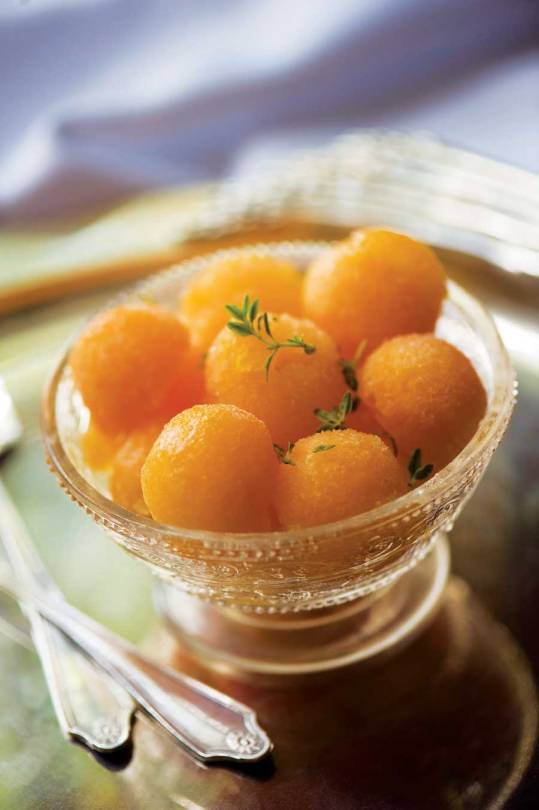
Orangeglo Watermelon
This unique orange watermelon offers great flavor to gardeners, even in regions normally considered too cool for conventional varieties.
By William Woys Weaver
Photo by ROB CARDILLO
#orangeglo watermelon#watermelon#watermelon recipes#melon recipe#summer eating#eat in season#seasonal eating#seasonal cooking#living off the land#homegrown food#growing fruit#mother earth news#sustainable living#sustainable farming#organic gardening#organic farming#organic food#real food#good food
13 notes
·
View notes
Photo

Mixed Heirloom organic Melon and Watermelon Seeds - Non-GMO, Fruit Seeds, Melon Seeds Bin#25 SURPRISE PACK Get your hands on melons and find out what other varieties you can grow in the comfort of your garden or home! A list of some of them will be listed below and we are offering them in this incredible package deal! Open-pollinated mixed varieties of seeds. 100% NON-GMO Real Survival Seeds. Guaranteed Fresh, Vegetable Gardening Seeds Non Hybrid Seeds GROWN IN THE USA A diverse gene pool mix of ultra-early, cool weather tolerant melons. Small, single serving, baseball-to-softball-sized melons vary in color (lots of green-fleshed but also some orange) as well as texture and flavor. You might not know what you’re going to get, but even the ones you’re less excited about are rather tasty. # of Seeds per Packet: 25+ Pepper Seeds Planting Instructions: Thrives in hot weather. Melons are ready to harvest when they easily slip off the vine when lifted. Sow seeds indoors 8-10 weeks before the last expected frost date in your area. Soak seeds in water for 4 days prior to sowing. Cover flats with a humidity dome to retain moisture and set in an 80-85°F location. Harden seedlings off gradually and transplant to a sunny garden location after all danger of frost is past and the weather is settled. For best results when starting seeds indoors use Seed Starting Mix and Trays. 10-12 Days for seeds to germinate from the date of sowing. 60-80 Days to maturity from the date of sowing your seeds. Germination rate 95% Sprouts In: 7-14 days Ideal Temp: 75 - 90 F Seed Depth: 1/2 inch Plant Spacing: 4' apart Light: Full Sun Days to Harvest: 60+ Days Species: Variety of Melons (incl watermelons). We do NOT make any claims that you will receive all 250+ seed varieties since we have no way of knowing which are which. Allsweet, Amish, Amarillo de Oro (Spain), Arancino, Ashkabad (Turkmenistan), Banana, Batekh Samara, Crane, Cavaillon Espagnol (Spain), Crenshaw, Casaba, Crenshaw, Cantaloupe Golden Summer, Charentais (France), Dune, Delice de la table, D'Alger (Algeria), De Almeria (Spain), Ethiopian, Golden Jenny, Galia, Golden Midget, Hara Madhu (India), Ha'Ogen, Healy's Pride, Honeydew Green Melon, Honey Rock Cantaloupe, Iridescent, Kajari (India), Kazakh (Kazakhistan), Kiku Chrysanthemum (Japan), Lemon Drop, Leelanau Sweetglo, Mango, Mahdu Ras (India), Noir de carmes (France), Olivin (Poland), Oregon, Queen Anne's Pocket, Petit gris de rennes, Prescott fond blanc, Piel de Sapo, Snow Leopard, Sweet Passion, Savor, Sweet Freckles, Sugar Baby Watermelon, Turkish Leopard (Turkey), Tiger, Thai Golden Round (Thailand), Thai Muskmelon (Thailand), Watermelon Crimson Sweet, White Lanzhou (China) Watermelon varieties may include Sugar Baby, Calsweet, Charleston Gray, Black Diamond, Jubilee, Allsweet, Crimson Sweet, Black Diamond, Shiny Boy, AU Producer, Charleston Grey, Desert King, Tendergold, Yellow Baby, Yellow doll, Crimson Sweet, Georgia Rattlesnake, Klondike Blue Ribbon Striped, Sweet Princess, Blacktail Mountain, Bush Sugar Baby, Sweet Beauty, Golden Midget, Little Darling, Mini Love, Black Diamond Yellow Belly, Carolina Cross #183, Florida Giant, Big Tasty, Mini Piccolo, Triple Crown, Orange Crisp, Orangeglo, Orange Tendersweet, Gold in Gold, Mountain Sweet Yellow, Yellow Petite, Cream of Saskatchewan, Kleckleys Sweet, Sangria F1 Hybrid What is the best way to plant watermelon? Sow your watermelon seeds in pots in mid-to-late May. In order to do this, fill some pots with seed-starting formula and sow each seed at a depth of 1 inch. You should sow 2-3 seeds per pot. Keep the soil moist and warm, at a temperature of 21 – 22°C What month do you plant watermelon? Plant watermelon from late spring to early summer, once soil temperatures reach 70° F or above. Space watermelon 3 to 5 feet apart in nutrient-rich, well-drained soil with a pH of 6.0 to 6.8. Sweet, fragrant, and brimming with juice, melons are the original thirst quencher. Since they’ve been cultivated for thousands of years, they come in an amazing range of sizes, colors, and shapes. The most popular type sold in the US is the orange-fleshed cantaloupe, which is actually a type of muskmelon, or netted melon. (True cantaloupes are smaller and available mostly in Europe and the Middle East.) Other grocery-store standards include the honeydew, a reliably sweet green-fleshed melon, and of course, numerous varieties of watermelons. But increasingly, more unusual types are found in local farmer’s markets from August through early autumn. FREE GIFT when you order 5 items or more. Free gift is full of surprise seeds which may include single or mixed varieties. Some, such as the Charentais, with its dark orange flesh and musky aroma, don’t ship well and are best bought locally. Other exotically-named varieties you might find include the slightly spicy Crenshaw, the super-sweet white-fleshed Canary, or the aptly named Tangerine Dream watermelon. Note: No tracking # will be provided to make the shipping cost-effective for us and free for you. Returns & exchanges Not accepted. But please contact me if you have problems with your order http://springsofeden.myshopify.com/products/mixed-heirloom-organic-melon-and-watermelon-seeds-non-gmo-fruit-seeds-melon-seeds-bin-25-surprise-pack
#Vegetable seeds#Heirloom melons#Non-GMO Seeds#seeds#organic seeds#Cantalopue Seeds#Fruit Seeds#Melon Seeds#Canary Melon#watermelon#amish melon#honeydew#kajari melon
2 notes
·
View notes
Photo
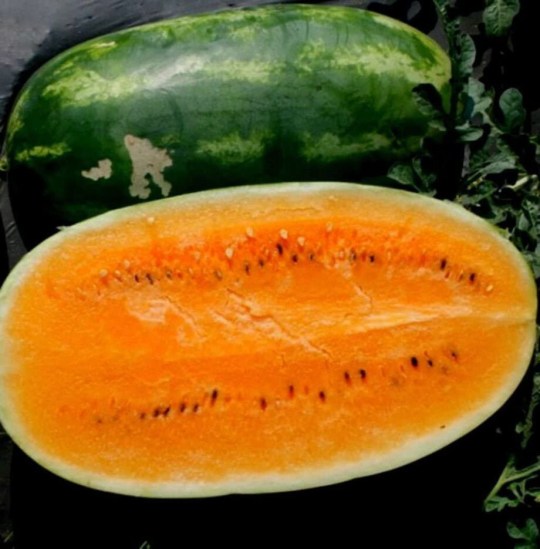
Tendersweet Orange Watermelon Seeds, Non-GMO, Organic, Heirloom, Open air Pollinated B25 This watermelon is an orange flesh variety. Producing large 10-15lb watermelons that are orange throughout and have minimal seeds. The rind is not as thick as other varieties, so its shelf life is not as long, but we have a feeling you won't have to worry about that. The fruit on this is sweet and juicy, without a hint of bitterness. Each plant can produce between 5-7 melons or 2-3 larger ones. Warm weather-loving and less susceptible to powdery mildew than other melons. Citrullus lanatus (90 days) Yummalicious orange, crisp, sweet, watermelon that is not only colorful but also intensely tasty. This is the standard for orange-fleshed watermelons. It is a long-type melon with markings similar to the All sweet type (dark green with lighter green strips). The average size is about 30 lbs. The taste and texture are excellent. An added advantage over Orangeglo is that the rind is tough enough to allow marketing at local/farmers' markets. This melon will be your favorite this summer, crisp, sweet, large, 35 pounds. This has a hollow heart, which I really enjoy. Seems to hold on the vine longer than most. Count: ~25+ This Heirloom is tender and very Sweet with oblong striped fruits that grow to 35 lbs Sow outdoors 4 weeks after the average last frost date and harvest in 90 days Plant Height is 15". plant spread is 72". yields 35 lb fruit Annual for all growing zones from 1-11. Sunlight exposure = full-sun Oblong Green Rind with Unique Juicy, Bright Orange Flesh High Sugar Content and Very Sweet Prefers Full Sun Exposure and Warm Weather FREE GIFT when you order 5 items or more. Free gift is full of surprise seeds which may include single or mixed varieties. Note: No tracking # will be provided to make the shipping cost-effective for us and free for you. Returns & exchanges Not accepted. But please contact me if you have problems with your order http://springsofeden.myshopify.com/products/tendersweet-orange-watermelon-seeds-non-gmo-organic-heirloom-open-air-pollinated-b25
0 notes